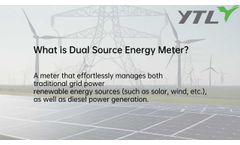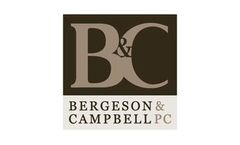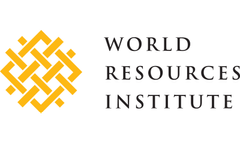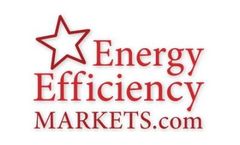Energy Use And Efficiency Policies Articles & Analysis: Older
36 articles found
The dual source energy meter usually refers to an energy meter that can simultaneously measure the input or output of two different types or sources of energy. This type of meter is particularly suitable for hybrid energy systems, such as those with traditional grid power and renewable energy sources (such as solar, wind, etc.), as well as diesel power generation.The following are some ...
ISO Certifications and Standards ISO certifications can easily be recognised by their respective numbering as they are very specific: each of them has a purpose. Hence, if you use them regularly, you will immediately associate ISO 9001 with quality, ISO 41001 with the environment, or ISO 50001 with energy efficiency. ...
On July 12, 2019, the House Renewable Energy & Energy Efficiency Caucus and the Environmental and Energy Study Institute co-hosted the 22nd Annual Congressional Renewable Energy and Energy Efficiency EXPO and Policy Forum. The forum brought together ...
The most valuable tool we have to meet the world’s growing energy demand while reducing greenhouse gas production could be figuring out how to use energy more efficiently. ...
ByEnsia
A number of international jurisdictions have articulated a longer term goal of zero emission housing standards. However, in Australia, housing energy efficiency remains a contested policy area. In part, this is due to a lack of clear cost-benefit information on low emission housing standards, including impacts at the household level. This research investigated the lifetime economics of low ...
Another study of aggregate job impacts found that energy efficiency and solar energy generate more direct jobs than coal, natural gas, and nuclear energy. ...
A National Geographic chart (see below) comparing country-wide GHG emissions with that of cities shows that Beijing is one of few cities that experiences a reverse city-country gap in GHG emissions, i.e. people use more energy per capita in cities than in rural areas. Most other Chinese cities share the same odd characteristic. ...
On October 2012, the European Union adopted the Energy Efficiency Directive in reaction to the fact that EU Member States were not on track to reduce primary energy consumption by 20 % by 2020. The implementation of this directive, and other policies that have been adopted in recent years, will require a change in consumer behaviour and energy consumption practices. Within this context, and ...
These programs would be similar to the new Warehouse for Energy Efficiency Loans (WHEEL) program. Revising Policies and Initiating Programs New state and local programs could use on-bill repayment or property taxes to fund energy efficiency. ...
We know that buildings use about (40)% of all energy use and we also know that the energy efficiency of buildings can be greatly improved, often just by better monitoring and controls with low capex and fast paybacks. ...
The energy efficiency industry received a nice boost this week during President Barack Obama’s State of the Union address. Obama called for cutting energy use by half over the next 20 years. Such attention comes at a significant point in the history of the energy efficiency movement, one ...
Coal-fired power plants are a major source of greenhouse gas emissions—one that could be increasing significantly globally, according to new analysis from the World Resources Institute. Several months ago, WRI began compiling and analyzing information about proposed new coal-fired plants in order to assess potential future risks to the global climate. We released our findings today in the ...
Is all this effort to save energy worth it? Consider this. Had we neglected energy efficiency from 1980 to 2010, worldwide energy use would be 35 percent higher. ...
For the first time, this paper estimates manufacturing subsector-specific energy use for the 10 states in the Midwestern Governors Association (MGA).2 Detailed manufacturing energy-use and economic activity data are presented alongside state-by-state policy summaries, giving a snapshot of where ...
Obama calls for about $1.2 billion in spending for energy efficiency. What’s this mean to the energy efficiency industry? ...
You might think by this headline that I’m about to rant about the news regarding energy efficiency policy that was circulating last week. President Obama outlined a plan called the Better Buildings Initiative to incentivize energy efficiency in commercial buildings during his visit to Penn State. ...
The article analyses Hungarian energy efficiency policies and measures in different sectors. The energy efficiency measures are ranked in the following sectors: energy, industry, transport, household and tertiary. The primary and final energy intensities and the energy efficiency index are examined in the frame of macroeconomic analysis. The energy consumption trends and the driving forces are ...
” But after hearing David Goldstein’s presentation, I must admit I’m thinking about energy efficiency in a whole different way. Goldstein, author of the book, “Invisible Energy: Strategies to Rescue the Economy and Save the Planet” crunched the numbers to show the enormous economic relief efficiency ...
Oil and natural gas, Kuwait's only resources of primary energy are also the only revenues from which national income is derived, including foreign exchange. Local energy consumption, excluding feedstock for refineries, estimated to be around 15% is increasing year by year, thus, posing a serious threat to the sustainable growth and financial well being of the country. Energy policy makers in ...
Second, on February 5 Obama drilled down to the nitty-gritty of energy efficiency policy. In a presidential memorandum, he called for the DOE to establish higher standards for common household appliances.“We’ll save through these simple steps over the next thirty years the amount of energy produced over a two-year period by all ...








